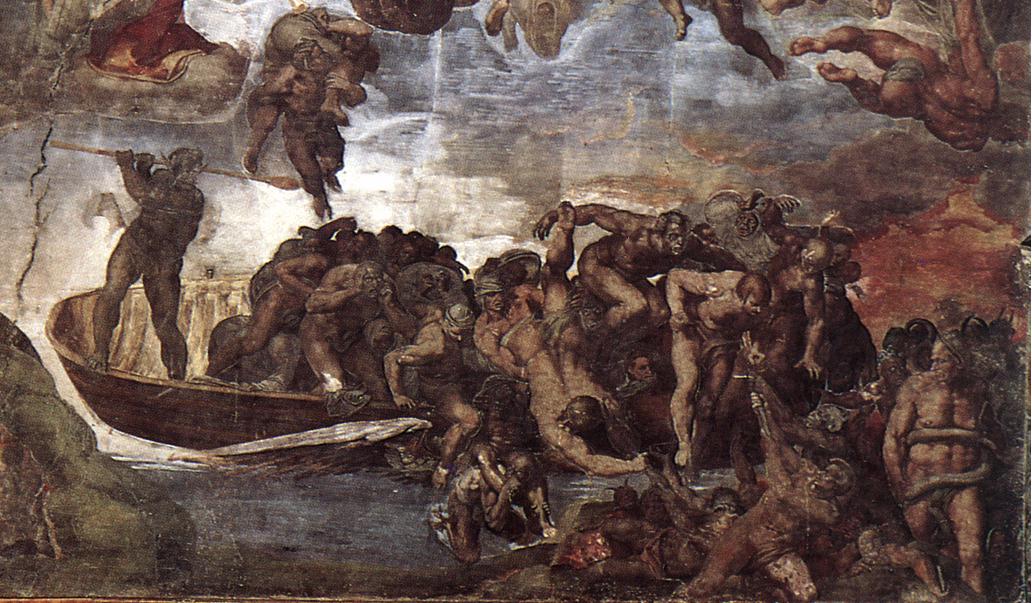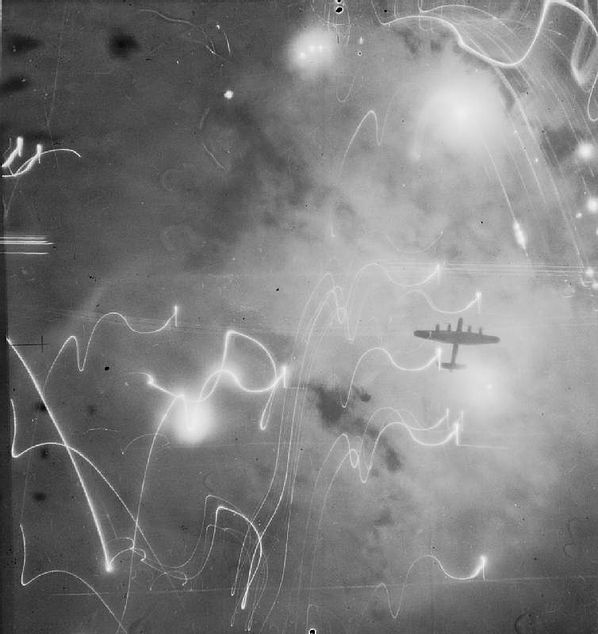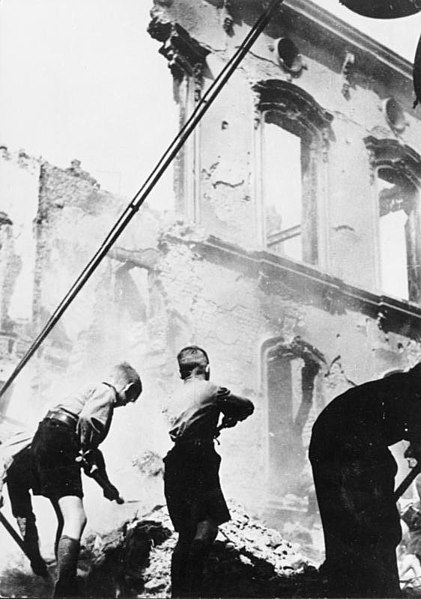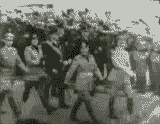.

Last Judgment (detail): Charon, the ferryman of the underworld, conducts the damned across the River Styx to Hell: Michelangelo Buonarroti, 1537-1541, fresco on altar wall of Sistine Chapel, the Vatican, Rome
At about eleven o'clock on the evening of July 25, 1943, the secretary of the Royal Italian Embassy in Berlin, Michele Lanza, was reclining comfortably in an armchair near the open window in the little bachelor apartment occupied by the press attaché, Cristiano Ridomi.
It was stiflingly hot, and the two friends, having extinguished the light and thrown the window wide open, were sitting in the dark room, smoking and chatting. Angela Lanza had left for Italy with her little girl a few days before, intending to pass the summer in her villa near Lake Como. (The families of foreign diplomats had left Berlin at the beginning of July in order to avoid not so much the suffocating heat of the Berlin summer as the air raids, which were becoming heavier each day.) And Michele Lanza, like the other Embassy officials, had got into the habit of spending his nights at the homes of various colleagues so as not to be left alone, shut up in a room, during the hours of darkness, which are the slowest of all to pass, and so that he might share with a friend, with a human being, the anguish and dangers of the raids.
That evening Lanza was in Ridomi's apartment, and the two friends were sitting in the darkness, discussing the massacre of Hamburg.
Berlin, Hitler Youth clearing ruins after air raid: photographer unknown, 1943 (Deutsches Bundesarchiv/German Federal Archive)
It was stiflingly hot, and the two friends, having extinguished the light and thrown the window wide open, were sitting in the dark room, smoking and chatting. Angela Lanza had left for Italy with her little girl a few days before, intending to pass the summer in her villa near Lake Como. (The families of foreign diplomats had left Berlin at the beginning of July in order to avoid not so much the suffocating heat of the Berlin summer as the air raids, which were becoming heavier each day.) And Michele Lanza, like the other Embassy officials, had got into the habit of spending his nights at the homes of various colleagues so as not to be left alone, shut up in a room, during the hours of darkness, which are the slowest of all to pass, and so that he might share with a friend, with a human being, the anguish and dangers of the raids.
That evening Lanza was in Ridomi's apartment, and the two friends were sitting in the darkness, discussing the massacre of Hamburg.

An Avro Lancaster of No. 1 Group, Bomber Command, silhouetted against flares, smoke and explosions during the attack on Hamburg, Germany, by aircraft of Nos. 1, 5 and 8 Groups on the night of 30/31 January 1943. This raid was the first occasion on which H2S centimetric radar was used by the Pathfinder aircraft to navigate the force to the target. The pilot of the photographing aircraft (Lancaster 'ZN-Y' of No. 106 Squadron, based at Syerston) was Flt Lt D J Shannon who, as a member of No. 617 Squadron, took part in Operation CHASTISE (the "Dams Raid") during the following May (Imperial War Museum)
The happenings described in the reports from the Royal Italian Consul in Hamburg were terrible. Whole districts of the city had been set alight by phosphorus bombs, which had claimed a great number of victims. There was nothing strange about that: even the Germans are mortal. But thousands and thousands of unfortunate people, dripping with burning phosphorus, had thrown themselves in the canals which cross Hamburg in every direction, into the river, the harbor, into ponds, even into the basins in the public gardens, hoping thereby to extinguish the flames that were devouring them; or they had had themselves covered over with earth in the trenches that had been dug here and there in the squares and streets to provide immediate shelter in the event of sudden raids. Clinging to the banks and to boats and immersed in water up to their mouths, or buried in the earth up to their necks, they waited for the authorities to find some antidote to those treacherous flames.

Hamburg, destruction after British air raid, firefighters battling the conflagration, 24 February 1943: photo by Walther
(Deutsches Bundesarchiv/German Federal Archive)
For the nature of phosphorus is such that that it adheres to the skin like a sticky leprous crust, and burns only when it comes in contact with the air. As soon as those wretched beings stuck an arm out of the ground or out of the water it started to burn like a torch. To protect themselves from the scourge the hapless victims were forced to remain immersed in the water or buried in the earth like the damned in Dante's Inferno. Rescue squads went from one to another of them, offering them food and drink, fastening those who were immersed in water to the bank with ropes lest, overcome by weariness, they should collapse and drown, and experimenting with all sorts of ointments. But their efforts were in vain; for while they were anointing an arm, or a leg, or a shoulder, having momentarily pulled it out of the water or out of the ground, the flames at once flared up again like little fiery serpents, and nothing availed to check the spread of that terrible burning corruption.
Hamburg, burned-out buildings after 1943 British bombing: from Martin Middlebrook: The Battle of Hamburg, 2000 (Imperial War Museum)
For a few days Hamburg presented the appearance of Dis, the infernal city. Here and there in the squares, in the streets, in the canals, in the Elbe, thousands and thousands of heads projected from the water and from the ground, looking as though they had been lopped off by the headsman's axe. Livid with terror and pain, they moved their eyes, opened their mouths and spoke. Those horrible heads, wedged between the paving stones of the streets or floating on the surface of the water, were visited night and day by their doomed owners' relatives, an emaciated, ragged throng, who spoke in low voices, as if to avoid intensifying their excruciating agony. Some brought food, drink and ointments, others brought cushions to place beneath the heads of their dear ones, some sat beside those who were buried in the ground and fanned their faces to bring them comfort in the heat of the day, while others sheltered their heads from the sun with umbrellas, or mopped their perspiring brows, or moistened their lips with soaking handkerchiefs, or straightened their hair with combs; some leaned from boats or from the bank of the canal or the river and consoled the doomed victims as they clung to their lines and moved to and fro with the current. Packs of dogs ran hither and thither, barking and licking the faces of their interred masters, or jumping into the water and swimming out to help them. Sometimes one of the doomed creatures, seized with impatience or despair, would utter a loud cry and attempt to escape from the water or from the ground, to put an end to the torment of his useless waiting; but immediately his limbs came in contact with the air they flared up, and dreadful scuffles broke out between the desperate victims and their relatives, who punched them with their fists, struck them with stones and sticks, or exerted the whole weight of their bodies in their efforts to push those dreadful heads back into the water or into the earth.

Destruction of the port facility, Free and Hanseatic city of Hamburg, more than 50% destroyed in British-American bombing raids, especially those of July-August 1943: photographer unknown, 1948 (Deutsches Bundesarchiv/German Federal Archive)
The bravest and the most patient were the children. They did not cry or call out, but looked about them with serene eyes, gazing at the fearful spectacle, and smiled at their relatives, with that wonderful resignation so characteristic of children, who forgive the impotence of their seniors, and pity those who cannot help them. As soon as night fell a whispering arose on all sides, a murmuring, as of the wind in the grass, and those thousands and thousands of heads watched the sky with eyes that were bright with horror.

Hamburg, view of the ruins near the Church of St. Michaelis, showing destruction after bombing attacks: photographer unknown, c. 1943-1945 (Deutsches Bundesarchiv/German Federal Archive)
On the seventh day the order was given for the removal of the civilian population from the localities where the doomed beings were buried in the ground or immersed in the water. The crowd of relatives silently withdrew, urged on gently by the soldiers and orderlies. The doomed victims were left alone. A terrified muttering, a gnashing of teeth, a stifled sobbing came from those horrible heads, which protruded above the water and the ground along the banks of the canals and the river, in the streets and the deserted squares. All day those heads talked among themselves, wept, cried out, with their mouths just above the surface of the ground, making frightful grimaces, putting out their tongues at the schupos on guard at the crossroads; and they seemed to be eating earth and spitting stones. Then night fell: and mysterious shadows moved among the doomed creatures and silently bent over them. From every side arose the sound of spades and shovels, and a splashing, and the dull plop of oars, and cries that were at once stifled, and moans, and the staccato crack of pistols.

Lanza and Ridomi sat talking of the massacre of Hamburg, and Lanza, who was near the window, shivered as he peered up at the dark starry sky. In due course Ridomi got up and switched on the radio, in order to hear the latest news from Rome. A woman's voice was singing in a sonorous, metallic void, to the accompaniment of a number of stringed instruments. The voice was warm, and it vibrated above the cold, strident sound of steel-stringed aluminium violins and violoncellos. Without warning the singing ceased, the instruments stopped playing, and the sudden silence that followed was shattered by a raucous voice: "Attention! Attention! This evening, at six o'clock, by order of His Majesty the King, the Head of the Government, Mussolini, was arrested. His Majesty the King has entrusted Marshal Badoglio with the task of forming the new Government." Lanza and Ridomi leapt to their feet and remained for a few moments in silence, facing each other across the dark room. The voice resumed its singing. Ridomi pulled himself together, closed the window and turned on the light.

Conversation between Hitler and Mussolini during negotiations in Munich on the assignment of the Czecho-Slovak border region of Germany: from left, Hermann Goering, Heinrich Himmler, Hitler (back to camera), Rudolf Hess, and Mussolini: photographer unknown, 29 September, 1938 (Deutsches Bundesarchiv/German Federal Archive)

Last Judgment (detail): Charon, the ferryman of the underworld, conducts the damned across the River Styx to Hell: Michelangelo Buonarroti, 1537-1541, fresco on altar wall of Sistine Chapel, the Vatican, Rome
Mussolini Executed: fragment of newsreel film, 1945, animated image by Alex: D, 2007
Curzio Malaparte: La Pelle (The Skin) (excerpt), 1949 (translated by David Moore, 1952)






5 comments:
Just glad to see you back, Tom. How'd you get that clip to work?
Thanks, Doowman. A little WD-40. (It's rude-mechanical week around here.)
Tom,
Yes, good to see you back -- this is totally intense, those "children with serene eyes," Charon taking us across to forgetfulness. . . . .
10.14
light coming into sky above still black
ridge, golden-crowned sparrow’s oh dear
in foreground, wave sounding in channel
lower right inscribe in pen,
place of same subject
such that what is could “be”
what is, outside, “see”
silver of sunlight reflected in channel,
shadowed green slope of ridge across it
Hi Tom. Welcome back. The visual images you've added to Malaparte's already overwhelming sensory account of Hamburg are (as these things so often tend to be) beautiful/horrible. They made everything realer and when I consulted history books to confirm that this all was real and discovered that it was, I began to feel sick/stupid even being alive when things like this are possible and are probably being repeated somewhere right now or will be very soon.
Steve, Curtis,
Yes, let's hope the devils stay in the box yet awhile... but there's always the troubling memory of
Pandaemonium.
Post a Comment